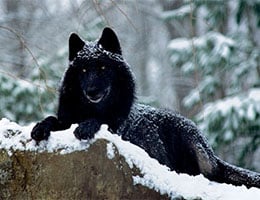 With etymological origin in the Latin word lupus , wolf is a term that refers to a mammalian animal that resembles the dog , although larger in size. The scientific name of the species is Canis lupus .
With etymological origin in the Latin word lupus , wolf is a term that refers to a mammalian animal that resembles the dog , although larger in size. The scientific name of the species is Canis lupus .
Wolves are quadrupeds whose body is covered in grayish fur, with an elongated tail and upright ears. These are wild animals that usually attack livestock, which is why they are often hunted by man.
Carnivores, wolves feed on deer, goats, sheep and reindeer, among other species . Many times they also hunt smaller specimens, such as birds and rodents.
In the wild, the wolf does not tend to attack humans . On the contrary, he prefers to avoid it and avoids contact. However, due to lack of food, a perception of danger or the proximity of its puppies, it can adopt an offensive attitude towards an individual of any species.
Among the many aspects to highlight about the wolf is its physical beauty, which results from a spectacular fusion of its hair, its look, its bearing and its attitude towards life. It is a majestic species, feared by its potential prey but also respected, given its almost divine presence in the forest .
The wolf does not take a wrong step; Unlike the dog, he seems to plan each movement before performing it, as if he wanted to avoid any waste of energy on trivial activities. It enjoys great agility, which allows it to make impressive jumps without running, reaching a great distance high and long.
Despite its ferocity , the wolf also knows how to have fun and can be extremely affectionate if it receives the treatment it expects. It is important to remember that it is not an enemy, but a living being like any other, although especially beautiful and powerful. His goal is not to bother anyone: he hunts to eat, not to sell or to hang the corpses on the walls. When he is not looking for food, he can spend pleasant times with his pack, playing with the younger ones or taking long naps.
Wolf communication is very complex, as it includes a combination of vocalizations and gestures with various parts of the body to express a wide range of messages and emotions. A look from you can be enough to convey your intentions to one of your companions, as much as denying it. Similarly, the different positions their ears can adopt also have particular meanings, such as "submissive" or "alert."
 The wolf uses its entire body to communicate: the way it stands, walks, sits or lies down must be interpreted in different ways, depending on the context. Regarding the use of its voice, its most characteristic vocalization is the howl, with which it produces unparalleled sounds , which can be as captivating as they are terrifying for whoever perceives them. In addition, the wolf can also bark, so its communication takes on different colors throughout the day.
The wolf uses its entire body to communicate: the way it stands, walks, sits or lies down must be interpreted in different ways, depending on the context. Regarding the use of its voice, its most characteristic vocalization is the howl, with which it produces unparalleled sounds , which can be as captivating as they are terrifying for whoever perceives them. In addition, the wolf can also bark, so its communication takes on different colors throughout the day.
The sea lion ( Otaria flavescens ), on the other hand, is an aquatic creature. Dark brown in color, it feeds on fish and lives in colonies on the South American coasts.
Sea lions are prey to orcas. Man, meanwhile, used to hunt them for their skin , meat and oil. Currently there are aquariums that have domesticated sea lions, which are forced to learn pirouettes and participate in different shows.
A werewolf , finally, is a mythological being that is also known as a werewolf . According to tradition, the werewolf has human appearance and behaviors until, under certain circumstances, it transforms into a wolf and becomes ferocious. Numerous books and movies have these beings as central characters.
